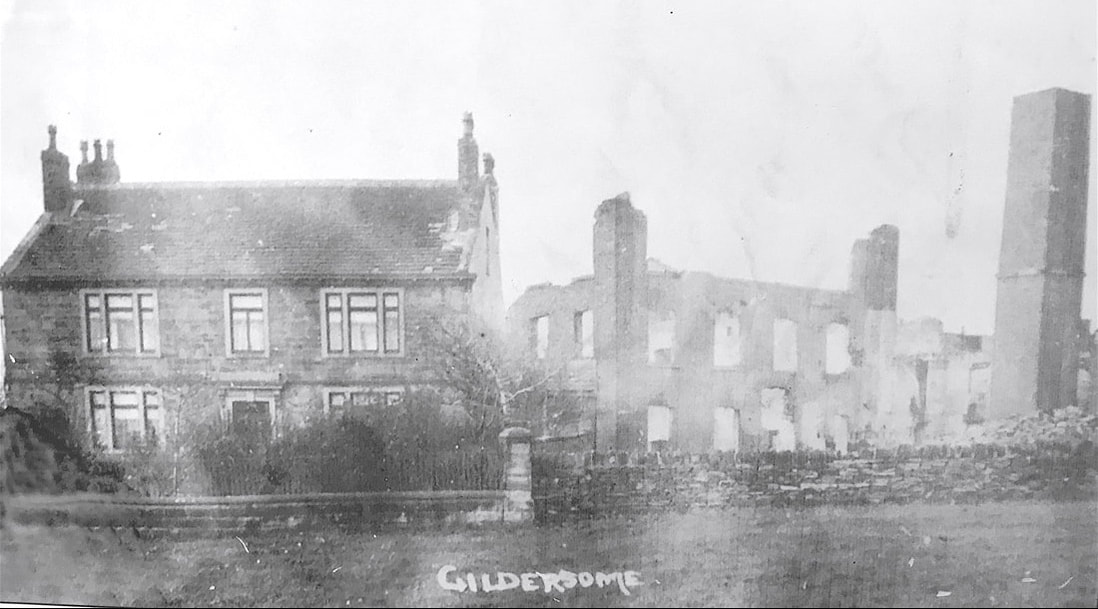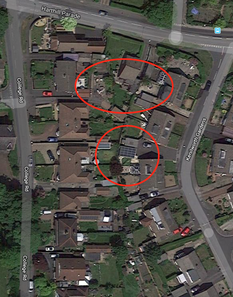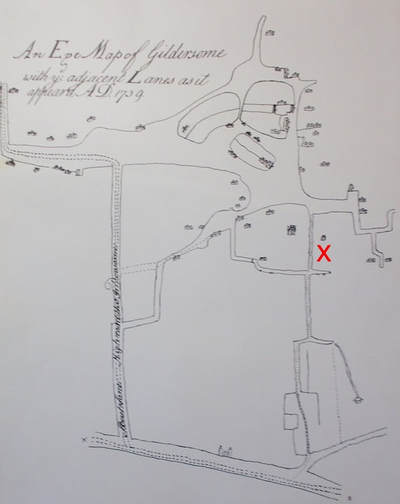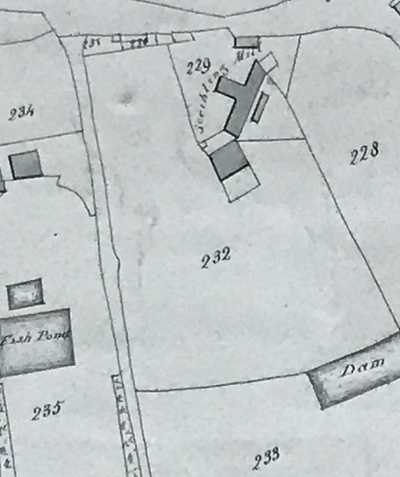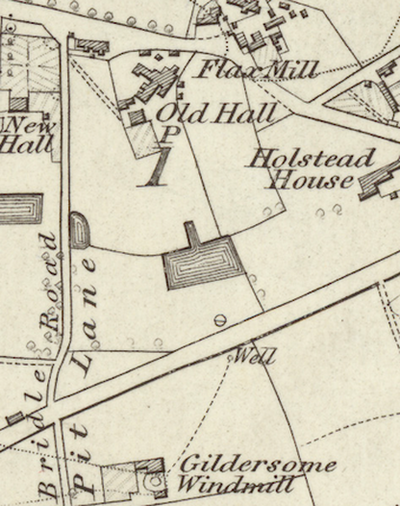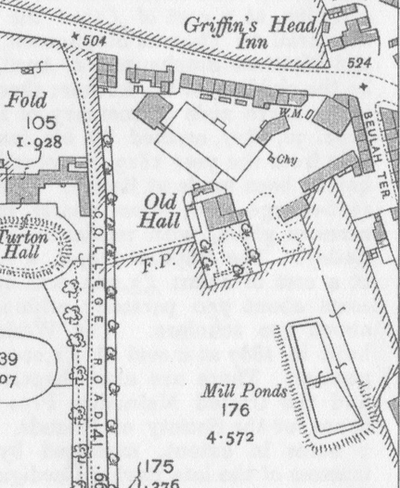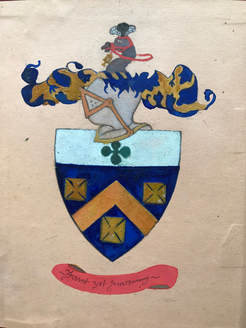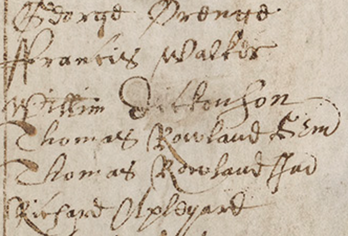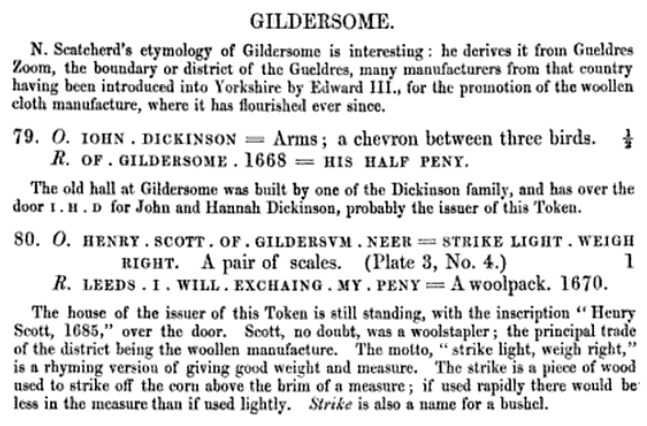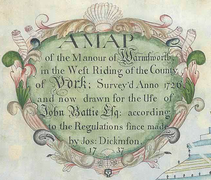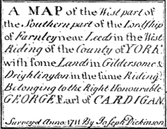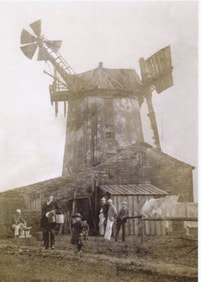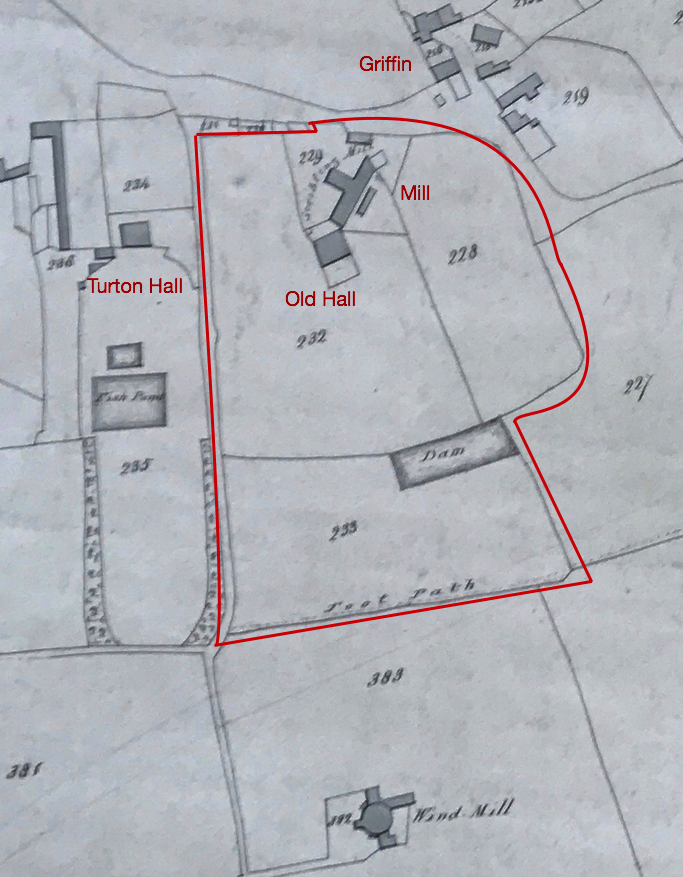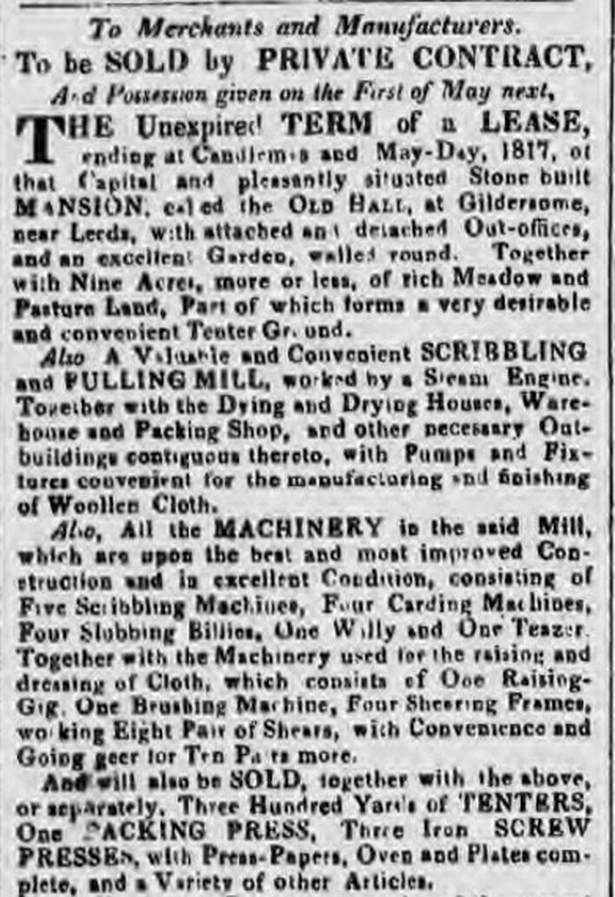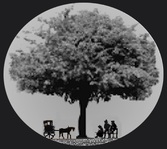The Old Hall - 1600s to 1800
Gildersome's Old Hall was indeed that - old! Parts of the original structure were first built in the Tudor period. It went through many alterations during its lifetime and probably assumed its square shape sometime around the end of the 18th century. In the 19th century it was described as being 17 yards in length and breadth which equals about 2600 square feet per floor. It survived until the 1970s. (Note: the chimney on the photo's right appears to lean due to a distortion in the image, it actually stood upright) (1)
Though we use the name "Old Hall" today, in the past that was not always so. It may have been known as Reyner's House (so called because it was the abode of the Reyner Family) or Gildersome Hall or something else entirely. Reyner's House may have been a century old when Turton Hall was built, so it became known as the Old Hall, a name that has endured since. In the book "The History of Morley" published in 1830, Norrison Scatchard wrote this about Gildersome's Old Hall:
The Old Hall was built by one of the Dickinson Family. It is a house of no great antiquity, evidently displaying more of the clumsy architecture of William the 3rd's reign than any other (J and H that is, John and Hannah Dickinson, are (carved) upon the front)*.............John Dickinson was related to William Dickinson, the Farnley Wood Plotter, but in what degree cannot now be discovered. Till lately his name, cut upon the pew at the north angle of the Chapel,** with the date 1698, was visible, but is now covered with green cloth............Respecting John Dickinson I have only to relate that it was he who built Gildersome "Old Hall"---- That he turned Quaker at the close of his life ---- That, with his daughter Hannah, he lies interred within the Chapel at the West corner, and that the family long lived in Gildersome Street.' ***
* Still visible in the 1890s **Old Chapel Morley *** Wakefield and Bradford Road.
At the time of Scatcherd's birth (1779), the events he wrote about above had taken place well over one hundred years before, yet those few sentences have endured as gospel to this very day. Those who came later, writing about the area's past, such as Smith, Booth and even 19th century Dickinson family historians simply accepted Scatcherd's claim. Scatcherd didn't know that in 1670, the aforesaid John Dickinson, sent a letter to his 'cousin' Job Lane in the colony of New England and in it was written:
"I bought that house and part of your land that Mr. Reyner was born in, that was his father's. Humphrey Reyner, our uncle, owned it and empowered his son-in-law William Hobson to sell it to me. I live in that house your father Reyner was born in." (2)
Scatcherd appears to have been mistaken as to the origin of the Old Hall and the 'William the 3rd' facade, which he so thoroughly disdained. The facade had been one of many modifications to a residence that began its life sometime around the start of the seventeenth century or maybe even earlier.
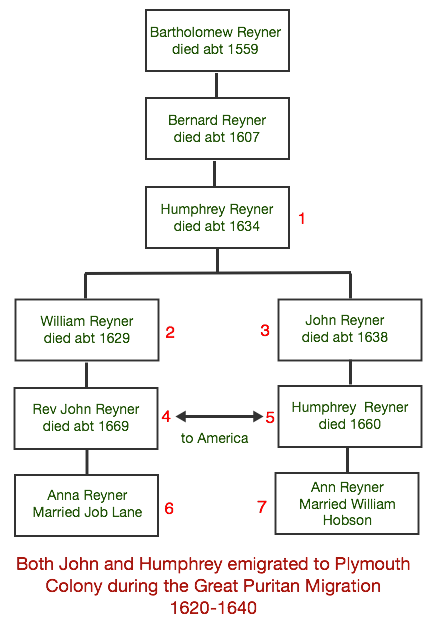
Reyner's House
The Reyner family is one of Gildersome's oldest continuous families. The earliest reference I've found for a Reyner in Gildersome is the will of Barthomew Reyner proven 1559. In it, Bartholomew appears to be clearly well off and though his will mentions lands in Carnyngall (Carlinghow), his Gildersome properties are not specifically named other than:
"The residue of my estate to Alice my wife and to Barnard, Umfray, and Robert, my sons, and to Anne my daughter, whom I make executors. I appoint Wilfray Raner my uncle to be supervisor of this my will."
Whether or not Bartholomew was the first Reyner ensconced at Gildersome remains to be seen. (3)
Rather than going deeply into Reyner genealogy, to help make sense of the relationships, use the chart on the right.
As mentioned above, in 1670 John Dickinson wrote the following to Job Lane (#6) in 1670 who was the son-in-law of the Rev. John Reyner (#4): "I bought that house and part of your land that Mr. Reyner was born in, that was his father's. Humphrey Reyner (#5), our uncle, owned it and empowered his son-in-law William Hobson (#7) to sell it to me. I live in that house your father (in-law) Reyner (#4) was born in." (4) As John Dickinson was born in 1627 and was quite young when the elder Reyners passed, he would have had quite an excellent knowledge of who was related to whom and where they lived.
The Reyner family is one of Gildersome's oldest continuous families. The earliest reference I've found for a Reyner in Gildersome is the will of Barthomew Reyner proven 1559. In it, Bartholomew appears to be clearly well off and though his will mentions lands in Carnyngall (Carlinghow), his Gildersome properties are not specifically named other than:
"The residue of my estate to Alice my wife and to Barnard, Umfray, and Robert, my sons, and to Anne my daughter, whom I make executors. I appoint Wilfray Raner my uncle to be supervisor of this my will."
Whether or not Bartholomew was the first Reyner ensconced at Gildersome remains to be seen. (3)
Rather than going deeply into Reyner genealogy, to help make sense of the relationships, use the chart on the right.
As mentioned above, in 1670 John Dickinson wrote the following to Job Lane (#6) in 1670 who was the son-in-law of the Rev. John Reyner (#4): "I bought that house and part of your land that Mr. Reyner was born in, that was his father's. Humphrey Reyner (#5), our uncle, owned it and empowered his son-in-law William Hobson (#7) to sell it to me. I live in that house your father (in-law) Reyner (#4) was born in." (4) As John Dickinson was born in 1627 and was quite young when the elder Reyners passed, he would have had quite an excellent knowledge of who was related to whom and where they lived.
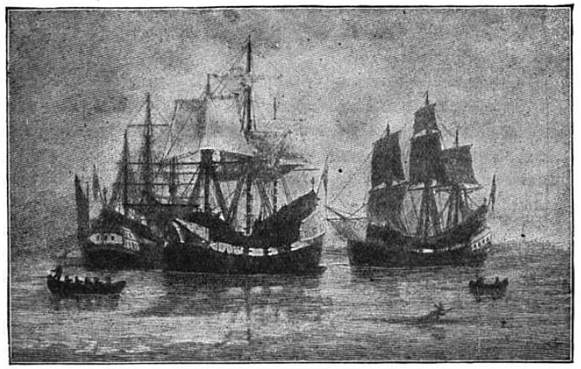 Part of the Winthrop Fleet preparing to embark for the Americas 1630. (7)
Part of the Winthrop Fleet preparing to embark for the Americas 1630. (7)
The Rev. John Reyner (#4) crossed to America in 1635 or 36, however, there is no record of his passage. His cousin, Humphrey (#5), followed in the summer of 1638 with his family, Mary (Middlebrook), his wife and his three daughters, Mary, Martha and Ann. They embarked aboard the good ship John of London which sailed from Hull to Boston. (5) "Humphrey Reyner (#5) became a freeman of Rowley, Essex County, Massachusetts Bay Colony on May 18, 1642. They had a three-acre house lot on Wethersfield Street in Rowley. He and his wife were buried in the Old Burying Ground in Rowley." (6)
In the will of the elder Humphrey Reyner (#1) of Gildersome, who died about 1634, he left to his grandson Humphrey (#5), a "house and close of land in Gildersome now in the occupation of Richard Fosard alias Coker which I lately bought of Thomas Milner of Morley; also three closes of land in Gildersome called "Sagar Roydes", now in the occupation of Thomas Crowther; also a new barn or lathe; also two crofts called "Magate Croftes", which I purchased of Henry Reyner of Notton; also a close called Deane Close." (8) He also left some trifles and money to daughter-in-law Mary and his granddaughters. In a curious entry, he also leaves to his grandson (#5) "all wainscot sealing I hanged within my now dwelling house." After a long list of bequests, Humphrey (#1) leaves 'The residue' of his estate to his son John (#3). There can be little doubt that the wainscotted dwelling was the residence that John Dickinson purchased.
John (#3), the elder Humphrey's (#1) heir, appears to either have hit upon hard times or voluntarily disposed of most of his property and wealth prior to composing his will. This is suggested in the relatively scant holdings of his estate without any 'residue', that all encompassing word which can mean a lot or a little; see his will below. Nor, did he leave any property or money to Humphrey (#5), only obligations. Humphrey (#5), and family had set out for the Plymouth colonies that same summer in which his father wrote his will (1638). The fact that Humphrey departed before his father's death lends further credence to the notion that John's estate was settled before Humphrey and his family embarked. By inference, it's clear that the wainscotted dwelling was passed on to Humphrey through his father. John Reyner died within a year.
"Will of John Reyner of Gildersome in the parish of Batley, yeoman, dated 24 Aug. 1638. To be buried in the church or churchyard of Batley. To my three daughters, Dorothy Reyner, Elizabeth Reyner, & Grace Reyner, £110 each. This is in accordance with what my daughter, Jane Smith, wife of John Smith, and my daughter Judith Reyner, wife of Marmaduke Reyner, have already had. If my estate do not "extend or surmount" to discharge these amounts, then my son & heir, Humphrey Reyner, shall make up the inheritances of my said three daughters out of certain lands in Gildersome as namely the "Squire Nephshey", one close of land called "Fold Close", two other closes of land called "Litel Moores", and another parcel of land called "Jaye Feld Lands", which said parcel I purchased of Henry Reyner of Noton. My wife [not named] to be sole executrix. [Signed] : John Reyner.
[Witnesses] : William Wood, William Bancke. (9)
There have been some differing opinions as to whether Humphrey Reyner (#5) was the half brother or the 1st cousin of the Reverend John Reyner (#4). A few words about that seem necessary. William (#2), in his will, left no property in Gildersome to his heir John Reyner (#4), unless it was included in that vague phrase, 'residue', nor was there any mention of a son named Humphrey. (10)
In the will of the elder Humphrey Reyner (#1) of Gildersome, who died about 1634, he left to his grandson Humphrey (#5), a "house and close of land in Gildersome now in the occupation of Richard Fosard alias Coker which I lately bought of Thomas Milner of Morley; also three closes of land in Gildersome called "Sagar Roydes", now in the occupation of Thomas Crowther; also a new barn or lathe; also two crofts called "Magate Croftes", which I purchased of Henry Reyner of Notton; also a close called Deane Close." (8) He also left some trifles and money to daughter-in-law Mary and his granddaughters. In a curious entry, he also leaves to his grandson (#5) "all wainscot sealing I hanged within my now dwelling house." After a long list of bequests, Humphrey (#1) leaves 'The residue' of his estate to his son John (#3). There can be little doubt that the wainscotted dwelling was the residence that John Dickinson purchased.
John (#3), the elder Humphrey's (#1) heir, appears to either have hit upon hard times or voluntarily disposed of most of his property and wealth prior to composing his will. This is suggested in the relatively scant holdings of his estate without any 'residue', that all encompassing word which can mean a lot or a little; see his will below. Nor, did he leave any property or money to Humphrey (#5), only obligations. Humphrey (#5), and family had set out for the Plymouth colonies that same summer in which his father wrote his will (1638). The fact that Humphrey departed before his father's death lends further credence to the notion that John's estate was settled before Humphrey and his family embarked. By inference, it's clear that the wainscotted dwelling was passed on to Humphrey through his father. John Reyner died within a year.
"Will of John Reyner of Gildersome in the parish of Batley, yeoman, dated 24 Aug. 1638. To be buried in the church or churchyard of Batley. To my three daughters, Dorothy Reyner, Elizabeth Reyner, & Grace Reyner, £110 each. This is in accordance with what my daughter, Jane Smith, wife of John Smith, and my daughter Judith Reyner, wife of Marmaduke Reyner, have already had. If my estate do not "extend or surmount" to discharge these amounts, then my son & heir, Humphrey Reyner, shall make up the inheritances of my said three daughters out of certain lands in Gildersome as namely the "Squire Nephshey", one close of land called "Fold Close", two other closes of land called "Litel Moores", and another parcel of land called "Jaye Feld Lands", which said parcel I purchased of Henry Reyner of Noton. My wife [not named] to be sole executrix. [Signed] : John Reyner.
[Witnesses] : William Wood, William Bancke. (9)
There have been some differing opinions as to whether Humphrey Reyner (#5) was the half brother or the 1st cousin of the Reverend John Reyner (#4). A few words about that seem necessary. William (#2), in his will, left no property in Gildersome to his heir John Reyner (#4), unless it was included in that vague phrase, 'residue', nor was there any mention of a son named Humphrey. (10)
|
The Dickinson Family
The Dickinson story begins with another John Dickinson, the grandfather of the John previously mentioned. Family historians claim that he was born in the County Palatine of Lancaster. It's not known when or why he arrived in Gildersome but an "Indenture in three parts," made out in 1609, refers back to an agreement made in 1604, which is the earliest known date placing him in Gildersome. (11) Those early deeds indicate that John Dickinson arrived at Gildersome with enough wealth to carve out a healthy chunk of its territory. A rumour, passed down through his descendants, claimed that the family was related to the ancient titled Dicconson family of Lancaster. This led to two of his great-great-grandsons, in 1735, to successfully petition the Royal College of Arms for the privilege, on certain occasions, to display the Dicconson Coat of Arms. (12) William Dickinson, the heir of the aforesaid John, was a clothier, married prior to 1624 and resided at Gildersome, most likely at the home of his father. William's name appears in the 1641-1642 Protestation Returns for Gildersome, which recorded the names of all males, 18 years of age or over who took a semi-mandatory oath to the King and the Church of England. (13) |
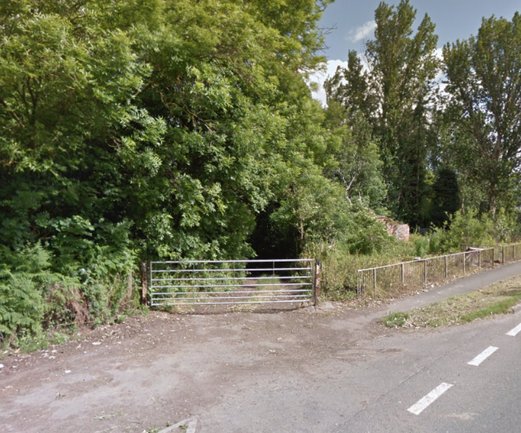 The Trench Lane gate on Gelderd Rd. In the woods, a little past the gate, is where the Farnley Plot meeting took place.
The Trench Lane gate on Gelderd Rd. In the woods, a little past the gate, is where the Farnley Plot meeting took place.
John Dickinson 2
William's heir, John Dickinson 2, purchased Reyner House sometime after the 1660 death of Humphrey Reyner. He was born in Gildersome at the old Dickinson family home and his baptism was recorded at Batley Church on the 9th of December 1627. According to family lore, he was apprenticed into the Grocer's guild in London and after his term of service, he returned to Gildersome and took up trade as a Drysalter. In 1656, he married Hannah Smith, the daughter of his neighbors John Smith the elder and Jane Reyner. (14) The Hearth Tax records of 1666 reported that, in Gildersome, John Smith Sr. had the grandest house, with 6 hearths, followed closely with 5 hearths each, by Joshua Greathead Jr. and John Dickinson. William Dickinson. John's younger brother, also appeared in the Gildersome tax records as living elsewhere in a more modest abode sporting only two chimneys. (15)
John and his brother William were involved in the events leading up to and after the Farnley Wood Plot. Both brothers appear to have been informers for the Royalists under the command of Joshua Greathead. William's role was more active than John's. Aside from being at the Farnley meeting, assuming the guise of a wanted criminal and aided by the issuance of a bogus arrest warrant, William skulked about much of southern England and then reported on the rebel groups that took him in. He was later pardoned. (16) His brother John was in attendance, on the 5th of April 1663, at the Morley Chapel Protest in which 200 protesters (by the authorities count) took over Morley's Old Chapel by "force of arms." Forbidden by Parliament, the protesters performed lengthy nonconformist services in the chapel. A warrant was issued on the 28th for John's arrest but he was never apprehended.(17) On the day of the Farnley plot, John did not attend the meeting at Trench Lane. Nevertheless, he was arrested anyway but was quickly released with a pardon, engineered by the Sheriff of York. In a petition to the King the sheriff wrote: “Joshua Greathead, John Dickinson, and Joseph Crowther. For their pardons without paying fees, His Majesty having been pleased to pardon their former offenses, for their services in discovering the late bloody and inhuman plot.” (18) See: Joshua Greathead and the Morley Chapel Protest
William's heir, John Dickinson 2, purchased Reyner House sometime after the 1660 death of Humphrey Reyner. He was born in Gildersome at the old Dickinson family home and his baptism was recorded at Batley Church on the 9th of December 1627. According to family lore, he was apprenticed into the Grocer's guild in London and after his term of service, he returned to Gildersome and took up trade as a Drysalter. In 1656, he married Hannah Smith, the daughter of his neighbors John Smith the elder and Jane Reyner. (14) The Hearth Tax records of 1666 reported that, in Gildersome, John Smith Sr. had the grandest house, with 6 hearths, followed closely with 5 hearths each, by Joshua Greathead Jr. and John Dickinson. William Dickinson. John's younger brother, also appeared in the Gildersome tax records as living elsewhere in a more modest abode sporting only two chimneys. (15)
John and his brother William were involved in the events leading up to and after the Farnley Wood Plot. Both brothers appear to have been informers for the Royalists under the command of Joshua Greathead. William's role was more active than John's. Aside from being at the Farnley meeting, assuming the guise of a wanted criminal and aided by the issuance of a bogus arrest warrant, William skulked about much of southern England and then reported on the rebel groups that took him in. He was later pardoned. (16) His brother John was in attendance, on the 5th of April 1663, at the Morley Chapel Protest in which 200 protesters (by the authorities count) took over Morley's Old Chapel by "force of arms." Forbidden by Parliament, the protesters performed lengthy nonconformist services in the chapel. A warrant was issued on the 28th for John's arrest but he was never apprehended.(17) On the day of the Farnley plot, John did not attend the meeting at Trench Lane. Nevertheless, he was arrested anyway but was quickly released with a pardon, engineered by the Sheriff of York. In a petition to the King the sheriff wrote: “Joshua Greathead, John Dickinson, and Joseph Crowther. For their pardons without paying fees, His Majesty having been pleased to pardon their former offenses, for their services in discovering the late bloody and inhuman plot.” (18) See: Joshua Greathead and the Morley Chapel Protest
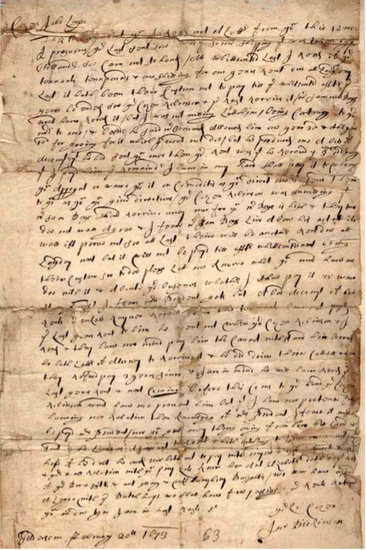 A letter from Dickinson to Lane. Found at the Bedford Historical Society.
A letter from Dickinson to Lane. Found at the Bedford Historical Society.
Hannah Dickinson, John's wife, was Hannah Smith, the daughter of Jane Reyner, and the the sister of Humphrey Reyner and also the 1st cousin to Rev. John Reyner, both spoken of above. John Dickinson assisted the New England heirs of Rev. John Reyner with the management of their property in Gildersome. For years John engaged them in an ongoing snail-paced communication that described many of the problems the 17th century colonists encountered when attempting to manage their affairs back home in Britian. These ranged from ships seized or sunk, bad property managers, land disputes with the descendants of John Reyner's first wife and dishonest shipping agents. Many of the letters have survived, but our interest is principally in those which were exchanged between Dickinson and his cousin-in-law, Job Lane. These can be found published in "Memoranda relating to the Lane, Reyner, and Whipple Families" Boston, Mass 1857 and on the Bedford Historical Society website. The letters contain little in the way of Gildersome historic facts and are long on Lane's dealings with those in England, i.e., shipping matters, complaints about unpaid rents, etc. Still, all in all, they make for a fascinating read. Here are a few snippets of John Dickinson, writing from Reyner's House, and taken from a letter sent to Job Lane on the 6th of March 1670: "Your letter dated 13 August last I rec'd in December; it was to my father (in-law) Smith. I (I'm) administrator, it came to my hands. I married his daughter, Hannah, in the year '56; have had 4 sons and 3 daughters since; one daughter dead, 4 sons and 2 daughters living, my wife big-bellies of one now; my wife's sister married to Jerm. Boulton in our town; hath two daughters. My wife's brother, married 12 years since; hath 4 sons, one daughter. My father Smith died in July '69; he never had anything (to do) with your land, ---- with that land that's beyond York that came by your mother, then that land that's in Gildersome that was your father (in-law) John Reyner's." At this point the author breaks into a lengthy description of problems with the collection of past and future rents. Later he divulges a few more personal details: "I deal in oil and dye-stuffs [and] I have them from London. I am at London commonly every August, but write thither every week.......A man that is married lives principally of no great action; that is contrary to my composition, I am for action, and have tracted England and Scotland, but now am much at home, having a shop to attend, I was born, and whilst a youth bred, in Gildersome, son to William Dickinson, in that town; your aunt Mary knows my father.
Old England is at a loss in sure things; the want of liberty of preaching, ... and trade that hath been formerly in our country for cloath which is much lamented." (19)
Old England is at a loss in sure things; the want of liberty of preaching, ... and trade that hath been formerly in our country for cloath which is much lamented." (19)
|
Left: Taken from a 19th century book on Trade Tokens In England during the 17th century. The production of a copper token was permitted by royal licence in the first few decades of the 17th century, but production ceased during the English Civil War. These tokens were most commonly made of copper or brass, but pewter and lead was permitted. In Yorkshire, 445 different tokens were minted, Gildersome is #79 and #80 in the list. The O = obverse or head of the token and R = the reverse. The three birds in the Dickinson crest are obviously mistaken for 3 crosses. Norrison Scatcherd appears to be the source of the comments. (20)
|
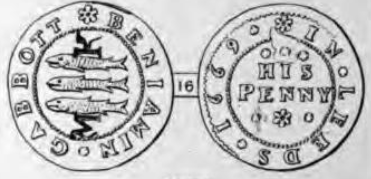
"Thoresby notes in his diary 29 June 1684 hearing a sermon preached by the Rev Mr Sharp (a well known non-conforming divine, and then pastor of St. Mary's Morley) in John Dickinson's house at Gildersome; he (Dickinson) was elected a trustee of the said Chapel and his name appears on the trust deed bearing (the) date 17 May 1687. And so recently as the early part of the present century his name was to be seen cut upon the pew in the north angle of the Chapel with (the) date 1698." (21) (above) An example of a trade token from Leeds.
Scatcherd wrote that near the end of his life John "turned Quaker" yet when he died he was buried at Morley's Old Chapel, a place that he dearly loved and where he had been a trustee. I believe Scatcherd's misconception developed because three of John's sons, William, Joseph and Samuel, became important members of the Society of Friends. It was son Joseph who provided the first land in Gildersome to the Society for the use of meetings and burials.
John Dickinson was buried 22 Aug 1704 and his wife Hannah was buried 3 Nov 1696, both at the Old Chapel, Morley. He named his oldest son, John Dickinson, his sole heir. (22)
Scatcherd wrote that near the end of his life John "turned Quaker" yet when he died he was buried at Morley's Old Chapel, a place that he dearly loved and where he had been a trustee. I believe Scatcherd's misconception developed because three of John's sons, William, Joseph and Samuel, became important members of the Society of Friends. It was son Joseph who provided the first land in Gildersome to the Society for the use of meetings and burials.
John Dickinson was buried 22 Aug 1704 and his wife Hannah was buried 3 Nov 1696, both at the Old Chapel, Morley. He named his oldest son, John Dickinson, his sole heir. (22)
John Dickinson 3
This John Dickinson was heir to the Reyner's House estate, which he received at his father's passing, but only held that title for six years. Whether disinterested, over-stretched or in dire straits financially, his reason may probably never be known. In 1710, he conveyed ownership of the Reyner's House to his brother Samuel who at that time was its occupant. (23) The entire deed as registered at Wakefield is presented here because it provides an early 18th century snapshot of the Estate and its properties (underlined). Keeping in mind that field boundaries and names change over time, the deed describes the fields surrounding the Old Hall that began at Harthill Parade, which then went south to Dean Beck at approximately a breadth of 300 to 400 metres. Several of the field names are familiar and can be placed on more recent Gildersome maps, they are; The Butts, Great Field, Lum Bottom and the West Moors. The West Moors were separate from the core of the Estate, fronting the Bradford & Wakefield Road, between Street Lane and Nepshaw. It's important to note that this was not the extent of the Dickinson's property in Gildersome. At the same time, Brothers Joseph, Samuel and William had holdings of their own.
This John Dickinson was heir to the Reyner's House estate, which he received at his father's passing, but only held that title for six years. Whether disinterested, over-stretched or in dire straits financially, his reason may probably never be known. In 1710, he conveyed ownership of the Reyner's House to his brother Samuel who at that time was its occupant. (23) The entire deed as registered at Wakefield is presented here because it provides an early 18th century snapshot of the Estate and its properties (underlined). Keeping in mind that field boundaries and names change over time, the deed describes the fields surrounding the Old Hall that began at Harthill Parade, which then went south to Dean Beck at approximately a breadth of 300 to 400 metres. Several of the field names are familiar and can be placed on more recent Gildersome maps, they are; The Butts, Great Field, Lum Bottom and the West Moors. The West Moors were separate from the core of the Estate, fronting the Bradford & Wakefield Road, between Street Lane and Nepshaw. It's important to note that this was not the extent of the Dickinson's property in Gildersome. At the same time, Brothers Joseph, Samuel and William had holdings of their own.
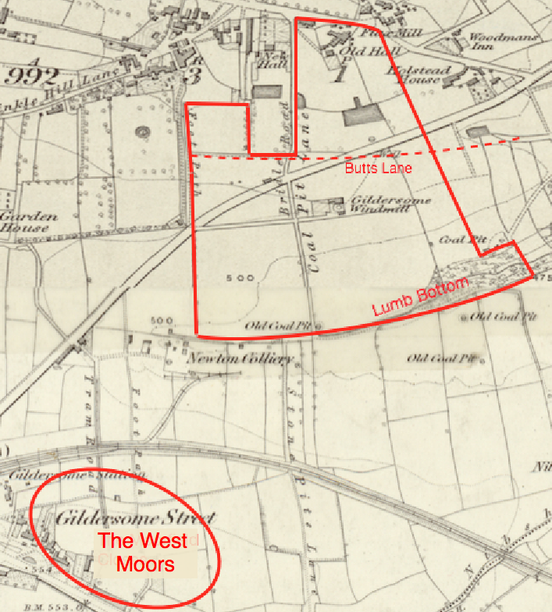 Best guess of the extent of the 1709 Dickinson Estate drawn on 1852 Ordnance Map for Gildersome
Best guess of the extent of the 1709 Dickinson Estate drawn on 1852 Ordnance Map for Gildersome
"An Indenture of Lease & Release bearing the date 27 & 28 Sep 1710 between John Dickinson citizen & Salter of London of the one part and Samuel Dickinson of Gildersome Co York Jersey Comber of the other part of concerning All that capital Messuage or Tenement wherein John Dickinson deceased did lately inhabit together with all the Outhouses and appurtenances thereunto belonging situate lying or being att Gildersome aforesaid now in the possession of the said Samuel Dickinson and also all those closes of meadow or pasture ground to the said Capital Massuage belonging (that is to say) one close called Broadcroft one other close called Ovenhouse croft both adjoining the said Messuage one other close called Lathe Croft adjoining the said Messuage on the North and New Lane on the west one other close called Wellcroft lying east of the said Messuage and one other close called Orchard croft adjoining the said Messuage and Barn on the west Two other closes called the Butts both adjoining the said Broadcroft one other close called Greatfields down to the beck called Lum Bottom and adjoining the Butts on the north one close called Bankfield adjoining field lane on the west and the lands of John Scott on the east lately purchased of one John Smith deceased one other close called Lum Bottom adjoining to the south side of the said Bankfield Two other closes called Moorfield Closes adjoining the lands of Isaac Reyner on the east and also all the sheaves of corn hay and grass which shall grow upon the same and all other Tythes or Glebe land Tenements and hereditaments whatsoever of him the said John Dickinson which were heretofore purchased of Sir Thomas Norcliffe which said indentures are witnessed by Nathanaell Denison of Leeds Gentleman Feaney? North of London and Robert Bishop of the same place Gent. ........"
Signed and Sealed by the above
named Sam'll Dickinson John Dickinson
in the Presence of Nathan'll Denison
Rey: Newstead (24)
Signed and Sealed by the above
named Sam'll Dickinson John Dickinson
in the Presence of Nathan'll Denison
Rey: Newstead (24)
Sandys B. Foster published a booklet entitled 'The Pedigree of Dickinson of Gildersome and Coalbrookdale and Darby'. In it the claim is made that: "John Dickinson, of Gildersome, purchased lands there from Sir Thomas Norcliffe and erected the Old Hall...." Of course, as has been demonstrated, this is only partially true. Sir Thomas Norcliffe and his son of the same name and title were contemporaries of both William Dickinson and John in turn. They were from Nunnington and held the Manor of Hunburton as well as tithed property in Gildersome and elsewhere. (25) If Foster had taken the time to read the registered deed a bit more closely, he might have noticed that the Norcliffe properties were those indentures specifically "witnessed by Nathanaell Denison" and the other gentlemen in the above deed. What he failed to grasp was that the 1710 deed was also witnessed by Nathanaell Denison, making the Norcliffe acquisitions fairly recent. (26)
A brief bio of John the third seems appropriate. Born in Gildersome, like his father he was apprenticed to a London grocer, Francis Chamberlain of Lawrence Pountney Lane. His service ended in 1692 and he immediately set up as a drysalter in the London parish of St. Peter le Poer. He made a very favourable match when he wed Elizabeth Marshe of Dunstable (1696). One of their sons, Marshe Dickinson, went on to become Lord Mayor of London 1756 - 1757. John had turned his back on Gildersome. His father, late in life, complained that John hadn't seen his mother in 12 years. He died in 1719. (27)
A brief bio of John the third seems appropriate. Born in Gildersome, like his father he was apprenticed to a London grocer, Francis Chamberlain of Lawrence Pountney Lane. His service ended in 1692 and he immediately set up as a drysalter in the London parish of St. Peter le Poer. He made a very favourable match when he wed Elizabeth Marshe of Dunstable (1696). One of their sons, Marshe Dickinson, went on to become Lord Mayor of London 1756 - 1757. John had turned his back on Gildersome. His father, late in life, complained that John hadn't seen his mother in 12 years. He died in 1719. (27)
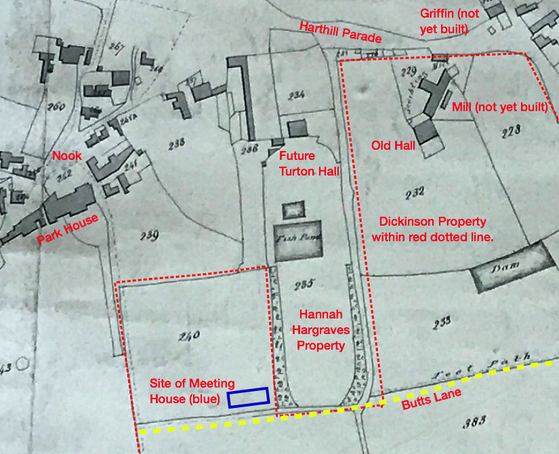 On 1800 Enclosure Map, approximate location of the Gildersome Meeting House
On 1800 Enclosure Map, approximate location of the Gildersome Meeting House
Samuel Dickinson, William Dickinson, Joseph Dickinson & Beyond
John Dickinson 2 had five sons, they were: John Dickinson 3, who is spoken about above, Joshua Dickinson who died young, Samuel, Joseph and William. All were born in Gildersome.
Samuel Dickinson, wool comber and purchaser of the Old Hall from his brother, converted to Quakerism sometime around 1700. His name appears frequently in meeting records and minutes as a proactive member and benefactor of the Society. He married Esther Wadsworth of Halifax but the union was unblessed by children. A failing business landed him in debtor's prison, London's Fleet, where he died in 1729.
William Dickinson, wool comber of Morley, joined the Society of Friends around the same time as his brother Samuel and later became a trustee and a minister. He married Rebecca Watson of Monk Hesleden County Durham. They had three children who died young. William died 1750.
Joseph Dickinson, Drysalter and Surveyor of note, left home at an early age. In 1694 he married Susannah Pearson of Oakenshaw and they settled at Woodhall in the parish of Womersley where he became deeply involved with the local Quaker congregations. He removed to Gildersome to in 1702 to take up the family business of a Drysalter. (28) Around 1705 the members of the Gildersome Friends, who had been previously meeting in various local homes, decided to purchase land for for a meeting house and burial ground of their own. Joseph agreed to provide a portion of his 'croft' for that purpose. In a deed of 'Feoffment' dated the 19th of January 1709, between Joseph Dickinson of Gildersome salter and his wife Susannah, of the 1st part and Robert Arthington of Farnley, Samuel Dickinson woolcomber of Gildersome, William Dickinson of Morley woolcomber, Thomas Benson of Gildersome and John Thackerah of Gildersome, of the 2nd; the described piece was transferred to the"People called Quakers": "all that piece or parcel of ground taken off the upper end of said Joseph Dickinson's Croft.....in Gildersome .....now in the tenure and occupation of the said Joseph Dickinson containing 29 yards in length & 20 yards in breadth.....as it is now Inclosed by Stoops & Rails & a Meeting house erected therein att the Publick Charge of Friends to Gildersome Meeting bounded on the East Against Hannah Hargreaves Upper Croft On the South Against Butts Lane On the West & North of the said Joseph Dickinson's Croft....& etc," The above named became the Meeting House's first trustees. (29)
With his brother Samuel's death and William's preoccupation with Quaker affairs, Joseph eventually took over management and later the ownership of all Dickinson property in Gildersome.
John Dickinson 2 had five sons, they were: John Dickinson 3, who is spoken about above, Joshua Dickinson who died young, Samuel, Joseph and William. All were born in Gildersome.
Samuel Dickinson, wool comber and purchaser of the Old Hall from his brother, converted to Quakerism sometime around 1700. His name appears frequently in meeting records and minutes as a proactive member and benefactor of the Society. He married Esther Wadsworth of Halifax but the union was unblessed by children. A failing business landed him in debtor's prison, London's Fleet, where he died in 1729.
William Dickinson, wool comber of Morley, joined the Society of Friends around the same time as his brother Samuel and later became a trustee and a minister. He married Rebecca Watson of Monk Hesleden County Durham. They had three children who died young. William died 1750.
Joseph Dickinson, Drysalter and Surveyor of note, left home at an early age. In 1694 he married Susannah Pearson of Oakenshaw and they settled at Woodhall in the parish of Womersley where he became deeply involved with the local Quaker congregations. He removed to Gildersome to in 1702 to take up the family business of a Drysalter. (28) Around 1705 the members of the Gildersome Friends, who had been previously meeting in various local homes, decided to purchase land for for a meeting house and burial ground of their own. Joseph agreed to provide a portion of his 'croft' for that purpose. In a deed of 'Feoffment' dated the 19th of January 1709, between Joseph Dickinson of Gildersome salter and his wife Susannah, of the 1st part and Robert Arthington of Farnley, Samuel Dickinson woolcomber of Gildersome, William Dickinson of Morley woolcomber, Thomas Benson of Gildersome and John Thackerah of Gildersome, of the 2nd; the described piece was transferred to the"People called Quakers": "all that piece or parcel of ground taken off the upper end of said Joseph Dickinson's Croft.....in Gildersome .....now in the tenure and occupation of the said Joseph Dickinson containing 29 yards in length & 20 yards in breadth.....as it is now Inclosed by Stoops & Rails & a Meeting house erected therein att the Publick Charge of Friends to Gildersome Meeting bounded on the East Against Hannah Hargreaves Upper Croft On the South Against Butts Lane On the West & North of the said Joseph Dickinson's Croft....& etc," The above named became the Meeting House's first trustees. (29)
With his brother Samuel's death and William's preoccupation with Quaker affairs, Joseph eventually took over management and later the ownership of all Dickinson property in Gildersome.
|
In 1715, Joseph and Susannah left Gildersome for North Elmsall in the Parish of South Kirkby. He took up the profession of surveying and produced some of the best surveys and maps of the period, his most famous being a 1750s Map of South Yorkshire, completed and published by his son William. Joseph died in 1739. Click on the two examples right:
|
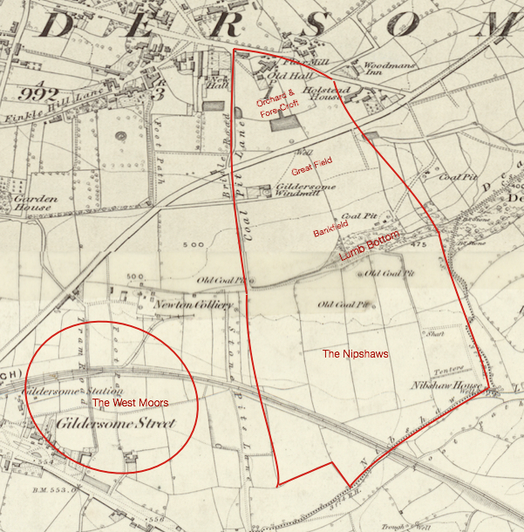
When Samuel died in 1729, the Reyner House Estate was put out to Let. The estate continued to be occupied by tenants for most of the next hundred years. It's not clear how far into the 1700s the heirs of Joseph Dickinson remained owners of the property, but this 1779 sale (below), which appeared in the Leeds Intelligencer, contains a clue that reveals the seller's identity to be the Dickinsons. Included in the sale was the West Moors property along the Street, this portion failed to sell and remained Dickinson property at least until 1804. (32) In the description of the sale there are many parcels of land whose names are recognisable, making a map of the estate fairly easy to create (below). Also demonstrated is the fact that the Dickinsons, especially in the early 1700s, had been busy accumulating properties, chiefly from the Reyners whose names appear in many of the Nipshaw fields.
"All that Capital MESSUAGE or MANSION-HOUSE, situate, lying and being in Gildersome, in the Parish of Batley, in the the County of York, commonly called or known by the Name of GILDERSOME OLD HALL, Together with a new Barn, and several cottages or Tenements near thereto, with other convenient Outbuildings; and also those several closes, Pieces or Parcels of Arable, Meadow, and Pasture Ground, adjoining or near to the said Mansion-House, commonly called or known by the several Names of Orchard, Fore-Croftes, Bank-Field, West-Moor, Lower and Middle Nipshaws, Dixon Nipshaw, Upper and Middle Rayner Nipshaws, Low Rayner Nipshaws, Squire Nipshaw, Great Nipshaw, Lumb Bottom, and Great-Field, containing together by Estimation fifty-eight Acres, or Seventy Seven Days Work and one Rood or thereabouts.
In this Estate there is a Colliery, and it is apprehended to contain a low Bed of Coal of Great Thickness, which has never been wrought.
☞ The Estate is now in the Possession of Francis Maude, Esq; under the clear yearly Rent of £84 whole interest therein expires at Candlemas next; when the Purchaser may enter into Possession of the Premises.
☞ GILDERSOME is situated in the Manufacturing Country, about five miles from Leeds, seven from Wakefield, and seven from Bradford; and the Buildings on this Estate render it most eligible Situation for a capital Manufacturer. (33)
The tenant of Old Hall (so called because the New Hall resided next door), at the time of the above sale, was Francis Maude, son of James Maude who constructed the New Hall around 1750. In the land immediately surrounding the New Hall was situated the Quaker Meeting House. Perhaps it spoiled Maude's prospect for it was said that it was he who coerced the Quakers to remove to Street Lane in 1756. (34) He built his "Capital Mansion House" all ringed with a stone fence and put in a well stocked fish pond. In 1767, the whole estate was offered for sale and included the Hall, six farms, several closes of land and two houses. Rather than the estate selling in one mass, it appears to have gone piecemeal over the course of several years. (35) The purchaser of the New Hall and it's immediate surrounds was John Turton who surprisingly was the 1779 purchaser of the Old Hall estate as well, sans the West Moors. This added an extra 50 acres, plus or minus, to his holding. In 1793, a Leeds newspaper ran an ad in which the Old Hall was once again offered for lease and, as part of its amenities, included a corn windmill, known to have been constructed by John Turton in the early 1780s. The windmill occupied a parcel of ground shown on the 1850s Tithe Map as Windmill Close but, prior to its construction, the field had been a Dickinson property know as the Great Field. Here is a portion of the advert:
"All that Capital MESSUAGE or MANSION-HOUSE, situate, lying and being in Gildersome, in the Parish of Batley, in the the County of York, commonly called or known by the Name of GILDERSOME OLD HALL, Together with a new Barn, and several cottages or Tenements near thereto, with other convenient Outbuildings; and also those several closes, Pieces or Parcels of Arable, Meadow, and Pasture Ground, adjoining or near to the said Mansion-House, commonly called or known by the several Names of Orchard, Fore-Croftes, Bank-Field, West-Moor, Lower and Middle Nipshaws, Dixon Nipshaw, Upper and Middle Rayner Nipshaws, Low Rayner Nipshaws, Squire Nipshaw, Great Nipshaw, Lumb Bottom, and Great-Field, containing together by Estimation fifty-eight Acres, or Seventy Seven Days Work and one Rood or thereabouts.
In this Estate there is a Colliery, and it is apprehended to contain a low Bed of Coal of Great Thickness, which has never been wrought.
☞ The Estate is now in the Possession of Francis Maude, Esq; under the clear yearly Rent of £84 whole interest therein expires at Candlemas next; when the Purchaser may enter into Possession of the Premises.
☞ GILDERSOME is situated in the Manufacturing Country, about five miles from Leeds, seven from Wakefield, and seven from Bradford; and the Buildings on this Estate render it most eligible Situation for a capital Manufacturer. (33)
The tenant of Old Hall (so called because the New Hall resided next door), at the time of the above sale, was Francis Maude, son of James Maude who constructed the New Hall around 1750. In the land immediately surrounding the New Hall was situated the Quaker Meeting House. Perhaps it spoiled Maude's prospect for it was said that it was he who coerced the Quakers to remove to Street Lane in 1756. (34) He built his "Capital Mansion House" all ringed with a stone fence and put in a well stocked fish pond. In 1767, the whole estate was offered for sale and included the Hall, six farms, several closes of land and two houses. Rather than the estate selling in one mass, it appears to have gone piecemeal over the course of several years. (35) The purchaser of the New Hall and it's immediate surrounds was John Turton who surprisingly was the 1779 purchaser of the Old Hall estate as well, sans the West Moors. This added an extra 50 acres, plus or minus, to his holding. In 1793, a Leeds newspaper ran an ad in which the Old Hall was once again offered for lease and, as part of its amenities, included a corn windmill, known to have been constructed by John Turton in the early 1780s. The windmill occupied a parcel of ground shown on the 1850s Tithe Map as Windmill Close but, prior to its construction, the field had been a Dickinson property know as the Great Field. Here is a portion of the advert:
"GILDERSOME --- TO BE LETT
ALL that CAPITAL MESSUAGE or MANSION-HOUSE, situate and being in Gildersome, in the Parish of Batley, and the County of York, commonly called Gildersome - Old Hall, with several Granaries or Warehouses, Shops, Barn, a Stable for six horses, and other convenient Outbuildings, together with a capital large Corn-Wind-Mill, containing Three Pair of Stones, with a Bolting Machine, a Granary, and all Convenience for Shelling of Oats, a Drying Kiln, a large Shed, a Dwelling-House for a Miller, a good pump with soft Water, and every other convenience together with several Closes of Arable, Meadow and Pasture Ground, lying contiguous to the said Mansion-House and Mill. Containing in Estimation Thirty Days Work" (36)
ALL that CAPITAL MESSUAGE or MANSION-HOUSE, situate and being in Gildersome, in the Parish of Batley, and the County of York, commonly called Gildersome - Old Hall, with several Granaries or Warehouses, Shops, Barn, a Stable for six horses, and other convenient Outbuildings, together with a capital large Corn-Wind-Mill, containing Three Pair of Stones, with a Bolting Machine, a Granary, and all Convenience for Shelling of Oats, a Drying Kiln, a large Shed, a Dwelling-House for a Miller, a good pump with soft Water, and every other convenience together with several Closes of Arable, Meadow and Pasture Ground, lying contiguous to the said Mansion-House and Mill. Containing in Estimation Thirty Days Work" (36)
|
The Old Windmill (left) was built around 1780 by John Turton and became part of the New Hall estate. The photograph, circa 1890, shows Ephram Ellis and his 2 children with masters from the Turton Hall Academy in the funny hats. Used to grind corn, the windmill fell into disrepair before this photo was shot and was demolished about 1970. (click to expand) (37) |
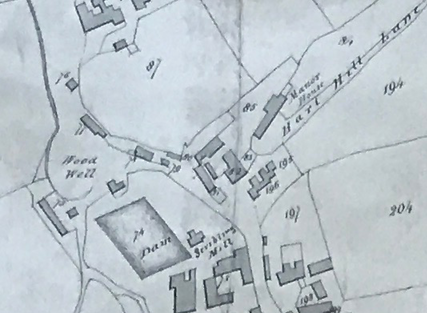 From WYAS 1824 Enclosure Map
From WYAS 1824 Enclosure Map
In an interesting aside, the launch of the windmill around about 1781 is significant in that it may provide a clue as to when the first scribbling mill was operating in Gildersome. Appearing in the Gildersome 1800 Enclosure Map is a scribbling mill near the old site of Maiden Mills between Reyner's fold and the Bottoms. Whether it was powered by water or steam is unknown. This was certainly the same site as a mill mentioned often in ancient records going back to the early 16th century. This old mill would have ground grains with a water wheel turning a stone, powered by water accumulated in its adjacent mill pond. (38) To all indications, the Windmill's advent signals a change at the pond from a cereal mill to a scribbling mill, as seen in the 1800 map above. Therefore, in order to make up the shortfall of milled grain, the windmill was built to replace the water mill. If this theory holds water, the Reyner's fold mill could be one of the earliest textile mills in the district. The only company found registered in the Gildersome land tax records for 1782 was Mess'rs Elam and Co., occupying a property owned by a Mr. Milnes. Perhaps they were the scribbling mill's operators. (39)
The above description of the Old Hall estate is also interesting because it gives the first clues of industrialisation conducted in the barn yard (hall yard) adjacent to the Hall. Within seven years, the hall yard will have evolved from a mix of minor industries into an established modern, for its times, textile mill.
|
The following two newspaper ads, 1809 and 1814 respectively, give a good description of the Old Hall and factory yard. In both caes, the owner is either John Turton or his heirs. As can be seen on the map to the right, the estate has diminished in size. The Hall itself had probably had its interior divided to provide housing for mill workers.
This is the start of an entirely new era for Gildersome and a great place to break off the narrative, which will be taken up at a later date. "To be SOLD by Private Contract A Very Valuable and Improveable FREEHOLD ESTATE, (Tithe-Free and Land-Tax redeemed) situated at Gildersome aforesaid, consisting of a Capital Stone-built Mansion in good repair, called the Old Hall, nearly Fourteen Yards Square, with a good Garden and Stable, and Nine Acres thereabouts of excellent Meadow and Pasture Land thereunto adjoining; also a good Wool Warehouse nearly the same size as the Mansion, A Fire Engine Twelve Horses Power, a Scribbling Mill, Slubbing Mill, and Fulling Mill; together with a Dye-House, Ware-Shop, Press-Shop and Packing -Shop, the Whole replete with every Convenience for a Merchant and Manufacturer." (40) |
The Old Hall Estate circa 1800
|
1] Photo courtesy of Peter Aldred
2] Bedford Historical Society; Lane Family Papers, #5 Letter from John Dickinson 1644
http://www.bedfordmahistory.org/Lane%20Family%20Papers/index.html
3] "History of an American Family" Will of Bartholomew Reyner:
http://www.branches-n-twigs.com/genealogy/getperson.php?personID=I15844&tree=allfam
4] Bedford Historical Society; Lane Family Papers, #5 Letter from John Dickinson 1644
http://www.bedfordmahistory.org/Lane%20Family%20Papers/index.html
5] WikiTree: John of London Passenger List, 1638. https://www.wikitree.com/wiki/Category:John_of_London%2C_sailed_1638
6] Blodgette, George Brainard, "Early Settlers of Rowley, Massachusetts Revised" 1981. Pg. 321.
7] W. F. Halsall - Tappan, Eva March. "An Elementary History of Our Country". New york: Houghton Mifflin Co., 1914. The initial group (Arbella
and her three escorts) departed Yarmouth, Isle of Wight on April 8, the remainder following in two or three weeks. Seven hundred men,
women, and children were distributed among the ships of the fleet. The voyage was rather uneventful, the direction and speed of the wind
being the main topic in Winthrop's journal, as it affected how much progress was made each day. There were a few days of severe weather, and
every day was cold. The children were cold and bored, and there is a description of a game played with a rope that helped with both problems.
Many were sick during the voyage
8] "Will of Humphrey Reyner of Gildersome" Proved, 24 Feb. 1635 [1635/6] by John Reyner the son & executor named. (Prerogative Court of
York, vol. 42, folio 691)
9] "Will of John Reyner of Gildersome" Proved, 2 Oct. 1639 (York Registry, Original Will.
10] "Will of William Reyner" Proved, 1 Dec. 1629, by John Reyner the son & executor named (Prerogative Court of York, vol. 40, folio 592):
"Will of William Reyner of Gildersome in the parish of Batley, yeoman, dated 28 Feb. 1628 [1628/9]. To be buried "where it shall please God
to appoint". To Thomas Reyner, one of my younger sons, and to his heirs, a cottage at Morley with appurtenences, a barn and two crofts, now
in the occupation of Nicholas Nailer. Also to the said Thomas Reyner, the rents, remainders, &c which I am to have after the decease of
Humfrey Reyner, my father, of six closes of lands calle "Priest Roids" in Morley, now in the occupation of my said father. To Samuell Reyner,
another of my younger sons, and to his heirs, all my rights in six closes called "Eleaven Roids" and "Pittye Closes" now occupied by me, in
Morley, which I lately purchased of John Truth, John Dickerson, and Christopher Scayf. To Judith Reyner, my daughter, £100. The residue of
my estate to John Reyner, my eldest son, and I make him executor of this my will, he to have tuition of my said younger children, Thomas,
Samuell, and Judith, during their minorities. John Reyner, my brother, and George Hardcastle to be supervisors.
[Witnesses] : John Smith, John Reyner, George Hardcastle, Ralfe Crowther.
11] WYAS 177/77, 10 Nov 1608-9. Indenture in three parts. Milnes Coates Gildersome Collection
12] "Earliest Records of the Family of Dickinson" a handwritten Victorian Notebook that I owned, now in the possession of the Morley Archives.
No author but Sandys B Foster suspected. Page 4
13] www.parliament.uk ; HL/PO/JO/10/1/109/4 - Protestation Return - York - West Riding - Agbrigg Wapentake – Warmfield, Crofton, Ardslaw
East [East Ardsley], Woodchurch [Woodkirk] alias Westardly [West Ardsley], Agkton [Ackton], Whitwood, Batley, Gildersome and Churwell.
Page 180
14] "Earliest Records of the Family of Dickinson" a handwritten Victorian Notebook that I owned, now in the possession of the Morley Archives.
No author but Sandys B Foster suspected. Page 18
15] "The history of Gildersome and the Booth Family" by Philip Henry Booth. Private Printing, 1920. Page 15
16] Nov. 2 1664, Letter: “Joshua Greathead to Sir Roger Langley. The three informers, Joshua Westerman, Wm. Dickinson and John Eastwood,
have been in most of the country betwixt and London, and find great discontent, and hopes of deliverance by the Dutch war, but no plot on
foot; wishes protection for the three men, who are poor, and live by their hard labor.” ’Charles II - volume 104: November 1-16, 1664', in
Calendar of State Papers Domestic: Charles II, 1664-5, ed. Mary Anne Everett Green (London, 1863), pp. 50-75.
July 2, 1670, Gildersome Nr. Leeds. Joshua Greathead to Sir Joseph Williamson: “Pray solicit Lord Arlington (Sir Henry Bennet) to procure the
release of Joshua Westerman, Luke Lone, Jacob Ellis, and Will. Dickinson, prisoners in York Castle. they were employed to find out persons
engaged in the late plot, and by order of Lord Arlington and Sir Thom. Gower, were to be supplied with money and whatever they wanted.
They did their best in the business, and were promised that they should live peaceably at home, and have done so till now, so their
imprisonment very much reflects upon Sir Thomas and my self, who are very much exclaimed against on their account. I suppose a former
application by Sir Thomas and me has not been received. Pray return my letter, and your thoughts as to what will become of the poor men.”
'Charles II: July 1670', in Calendar of State Papers Domestic: Charles II, 1670 With Addenda 1660-70, ed. Mary Anne Everett Green
(London, 1895), pp. 309-358. [S.P. Dom. Car. II. 277, No. 8.]
17] West Yorkshire Archive Service: Yorkshire, England, Quarter Session Records, 1637-1914, 1681-1686, Wakefield, Order, 28 April 1663
18] ’Charles II - volume 89: Undated 1663', in Calendar of State Papers Domestic: Charles II, 1663-4, ed. Mary Anne Everett Green (London,
1862), pp. 413-426.
19] Bedford Historical Society; Lane Family Papers, #5 Letter from John Dickinson 1644
http://www.bedfordmahistory.org/Lane%20Family%20Papers/index.html
20] " Tokens issued in the seventeenth, eighteenth, and nineteenth centuries, in Yorkshire, by tradesmen, overseers of the poor, etc., in gold, silver
brass and copper. Also the seals of all the corporations in that county." by Boyne, William, 1858-1893. Published 1858.
21] "The Pedigree of Dickinson of Gildersome and Coalbrookdale and Darby" by Sandys Foster, 1890
22] "Earliest Records of the Family of Dickinson" a handwritten Victorian Notebook that I owned, now in the possession of the Morley Archives.
No author but Sandys B Foster suspected. Page 22
23] "Earliest Records of the Family of Dickinson" a handwritten Victorian Notebook that I owned, now in the possession of the Morley Archives.
No author but Sandys B Foster suspected. Page 42
24] West Yorkshire Archive Service, Registry of Deed at Wakefield. Deed number: E 111 150
25] The Yorkshire Archaeological Journal Vol 3.
26] The Pedigree of Dickinson of Gildersome and Coalbrookdale, Darby of Coalbrookdale, Salop, Darby of Stoke Court, Bucks, Fowler of
Melksham, Wilts, Rathbone of Liverpool – Sandys Birket Foster
27] "Earliest Records of the Family of Dickinson" a handwritten Victorian Notebook that I owned, now in the possession of the Morley Archives.
No author but Sandys B Foster suspected. Page 52
28] "Earliest Records of the Family of Dickinson" a handwritten Victorian Notebook that I owned, now in the possession of the Morley Archives.
No author but Sandys B Foster suspected. Various pages.
29] "Quakers in Gildersome" Jean E. Mortimer, publish by the Author at Leeds. Pages 4, 5, 6
30] Christies Website, sold Items: "A Map of the Manor of Warmsworth in the West Riding of the County of York, surveyed anno 1726"
https://www.christies.com/lotfinder/books-manuscripts/joseph-dickinson5829963details.aspxfrom=searchresults&intObjectID=
5829963&sid=a49a8c36-4b32-4fe8-852c-ec73f6fd08c8
31] Unknown Source
32] Ancestry.com. West Yorkshire, England, Select Land Tax Records, 1704-1932 [database on-line]. Provo, UT, USA: Ancestry.com Operations,
Inc., 2014.
33] Leeds Intelligencer 7 June 1779
34] "Quakers in Gildersome" Jean E. Mortimer, publish by the Author at Leeds. Page 25
35] "The history of Gildersome and the Booth Family" by Philip Henry Booth. Private Printing, 1920. Page 19 & 20
36] Leeds Intelligencer 23 Sep 1793
37] "Windmills of Yorkshire" by Roy Gregory, Laurence Turner; Stenlake Publishing, 2009
38] 'Yorkshire Fines: 1500-1505', in Feet of Fines of the Tudor Period [Yorks]: Part 1, 1486-1571, ed. Francis Collins (Leeds, 1887), pp. 14-20.
British History Online http://www.british-history.ac.uk/feet-of-fines-yorks/vol1/pp14-20 [accessed 14 August 2018].
39] West Yorkshire, Land Tax, 1703–1932. West Yorkshire Archive Service, Wakefield, England. Year 1782
40] Leeds Intelligencer 11 Jan 1809
2] Bedford Historical Society; Lane Family Papers, #5 Letter from John Dickinson 1644
http://www.bedfordmahistory.org/Lane%20Family%20Papers/index.html
3] "History of an American Family" Will of Bartholomew Reyner:
http://www.branches-n-twigs.com/genealogy/getperson.php?personID=I15844&tree=allfam
4] Bedford Historical Society; Lane Family Papers, #5 Letter from John Dickinson 1644
http://www.bedfordmahistory.org/Lane%20Family%20Papers/index.html
5] WikiTree: John of London Passenger List, 1638. https://www.wikitree.com/wiki/Category:John_of_London%2C_sailed_1638
6] Blodgette, George Brainard, "Early Settlers of Rowley, Massachusetts Revised" 1981. Pg. 321.
7] W. F. Halsall - Tappan, Eva March. "An Elementary History of Our Country". New york: Houghton Mifflin Co., 1914. The initial group (Arbella
and her three escorts) departed Yarmouth, Isle of Wight on April 8, the remainder following in two or three weeks. Seven hundred men,
women, and children were distributed among the ships of the fleet. The voyage was rather uneventful, the direction and speed of the wind
being the main topic in Winthrop's journal, as it affected how much progress was made each day. There were a few days of severe weather, and
every day was cold. The children were cold and bored, and there is a description of a game played with a rope that helped with both problems.
Many were sick during the voyage
8] "Will of Humphrey Reyner of Gildersome" Proved, 24 Feb. 1635 [1635/6] by John Reyner the son & executor named. (Prerogative Court of
York, vol. 42, folio 691)
9] "Will of John Reyner of Gildersome" Proved, 2 Oct. 1639 (York Registry, Original Will.
10] "Will of William Reyner" Proved, 1 Dec. 1629, by John Reyner the son & executor named (Prerogative Court of York, vol. 40, folio 592):
"Will of William Reyner of Gildersome in the parish of Batley, yeoman, dated 28 Feb. 1628 [1628/9]. To be buried "where it shall please God
to appoint". To Thomas Reyner, one of my younger sons, and to his heirs, a cottage at Morley with appurtenences, a barn and two crofts, now
in the occupation of Nicholas Nailer. Also to the said Thomas Reyner, the rents, remainders, &c which I am to have after the decease of
Humfrey Reyner, my father, of six closes of lands calle "Priest Roids" in Morley, now in the occupation of my said father. To Samuell Reyner,
another of my younger sons, and to his heirs, all my rights in six closes called "Eleaven Roids" and "Pittye Closes" now occupied by me, in
Morley, which I lately purchased of John Truth, John Dickerson, and Christopher Scayf. To Judith Reyner, my daughter, £100. The residue of
my estate to John Reyner, my eldest son, and I make him executor of this my will, he to have tuition of my said younger children, Thomas,
Samuell, and Judith, during their minorities. John Reyner, my brother, and George Hardcastle to be supervisors.
[Witnesses] : John Smith, John Reyner, George Hardcastle, Ralfe Crowther.
11] WYAS 177/77, 10 Nov 1608-9. Indenture in three parts. Milnes Coates Gildersome Collection
12] "Earliest Records of the Family of Dickinson" a handwritten Victorian Notebook that I owned, now in the possession of the Morley Archives.
No author but Sandys B Foster suspected. Page 4
13] www.parliament.uk ; HL/PO/JO/10/1/109/4 - Protestation Return - York - West Riding - Agbrigg Wapentake – Warmfield, Crofton, Ardslaw
East [East Ardsley], Woodchurch [Woodkirk] alias Westardly [West Ardsley], Agkton [Ackton], Whitwood, Batley, Gildersome and Churwell.
Page 180
14] "Earliest Records of the Family of Dickinson" a handwritten Victorian Notebook that I owned, now in the possession of the Morley Archives.
No author but Sandys B Foster suspected. Page 18
15] "The history of Gildersome and the Booth Family" by Philip Henry Booth. Private Printing, 1920. Page 15
16] Nov. 2 1664, Letter: “Joshua Greathead to Sir Roger Langley. The three informers, Joshua Westerman, Wm. Dickinson and John Eastwood,
have been in most of the country betwixt and London, and find great discontent, and hopes of deliverance by the Dutch war, but no plot on
foot; wishes protection for the three men, who are poor, and live by their hard labor.” ’Charles II - volume 104: November 1-16, 1664', in
Calendar of State Papers Domestic: Charles II, 1664-5, ed. Mary Anne Everett Green (London, 1863), pp. 50-75.
July 2, 1670, Gildersome Nr. Leeds. Joshua Greathead to Sir Joseph Williamson: “Pray solicit Lord Arlington (Sir Henry Bennet) to procure the
release of Joshua Westerman, Luke Lone, Jacob Ellis, and Will. Dickinson, prisoners in York Castle. they were employed to find out persons
engaged in the late plot, and by order of Lord Arlington and Sir Thom. Gower, were to be supplied with money and whatever they wanted.
They did their best in the business, and were promised that they should live peaceably at home, and have done so till now, so their
imprisonment very much reflects upon Sir Thomas and my self, who are very much exclaimed against on their account. I suppose a former
application by Sir Thomas and me has not been received. Pray return my letter, and your thoughts as to what will become of the poor men.”
'Charles II: July 1670', in Calendar of State Papers Domestic: Charles II, 1670 With Addenda 1660-70, ed. Mary Anne Everett Green
(London, 1895), pp. 309-358. [S.P. Dom. Car. II. 277, No. 8.]
17] West Yorkshire Archive Service: Yorkshire, England, Quarter Session Records, 1637-1914, 1681-1686, Wakefield, Order, 28 April 1663
18] ’Charles II - volume 89: Undated 1663', in Calendar of State Papers Domestic: Charles II, 1663-4, ed. Mary Anne Everett Green (London,
1862), pp. 413-426.
19] Bedford Historical Society; Lane Family Papers, #5 Letter from John Dickinson 1644
http://www.bedfordmahistory.org/Lane%20Family%20Papers/index.html
20] " Tokens issued in the seventeenth, eighteenth, and nineteenth centuries, in Yorkshire, by tradesmen, overseers of the poor, etc., in gold, silver
brass and copper. Also the seals of all the corporations in that county." by Boyne, William, 1858-1893. Published 1858.
21] "The Pedigree of Dickinson of Gildersome and Coalbrookdale and Darby" by Sandys Foster, 1890
22] "Earliest Records of the Family of Dickinson" a handwritten Victorian Notebook that I owned, now in the possession of the Morley Archives.
No author but Sandys B Foster suspected. Page 22
23] "Earliest Records of the Family of Dickinson" a handwritten Victorian Notebook that I owned, now in the possession of the Morley Archives.
No author but Sandys B Foster suspected. Page 42
24] West Yorkshire Archive Service, Registry of Deed at Wakefield. Deed number: E 111 150
25] The Yorkshire Archaeological Journal Vol 3.
26] The Pedigree of Dickinson of Gildersome and Coalbrookdale, Darby of Coalbrookdale, Salop, Darby of Stoke Court, Bucks, Fowler of
Melksham, Wilts, Rathbone of Liverpool – Sandys Birket Foster
27] "Earliest Records of the Family of Dickinson" a handwritten Victorian Notebook that I owned, now in the possession of the Morley Archives.
No author but Sandys B Foster suspected. Page 52
28] "Earliest Records of the Family of Dickinson" a handwritten Victorian Notebook that I owned, now in the possession of the Morley Archives.
No author but Sandys B Foster suspected. Various pages.
29] "Quakers in Gildersome" Jean E. Mortimer, publish by the Author at Leeds. Pages 4, 5, 6
30] Christies Website, sold Items: "A Map of the Manor of Warmsworth in the West Riding of the County of York, surveyed anno 1726"
https://www.christies.com/lotfinder/books-manuscripts/joseph-dickinson5829963details.aspxfrom=searchresults&intObjectID=
5829963&sid=a49a8c36-4b32-4fe8-852c-ec73f6fd08c8
31] Unknown Source
32] Ancestry.com. West Yorkshire, England, Select Land Tax Records, 1704-1932 [database on-line]. Provo, UT, USA: Ancestry.com Operations,
Inc., 2014.
33] Leeds Intelligencer 7 June 1779
34] "Quakers in Gildersome" Jean E. Mortimer, publish by the Author at Leeds. Page 25
35] "The history of Gildersome and the Booth Family" by Philip Henry Booth. Private Printing, 1920. Page 19 & 20
36] Leeds Intelligencer 23 Sep 1793
37] "Windmills of Yorkshire" by Roy Gregory, Laurence Turner; Stenlake Publishing, 2009
38] 'Yorkshire Fines: 1500-1505', in Feet of Fines of the Tudor Period [Yorks]: Part 1, 1486-1571, ed. Francis Collins (Leeds, 1887), pp. 14-20.
British History Online http://www.british-history.ac.uk/feet-of-fines-yorks/vol1/pp14-20 [accessed 14 August 2018].
39] West Yorkshire, Land Tax, 1703–1932. West Yorkshire Archive Service, Wakefield, England. Year 1782
40] Leeds Intelligencer 11 Jan 1809

